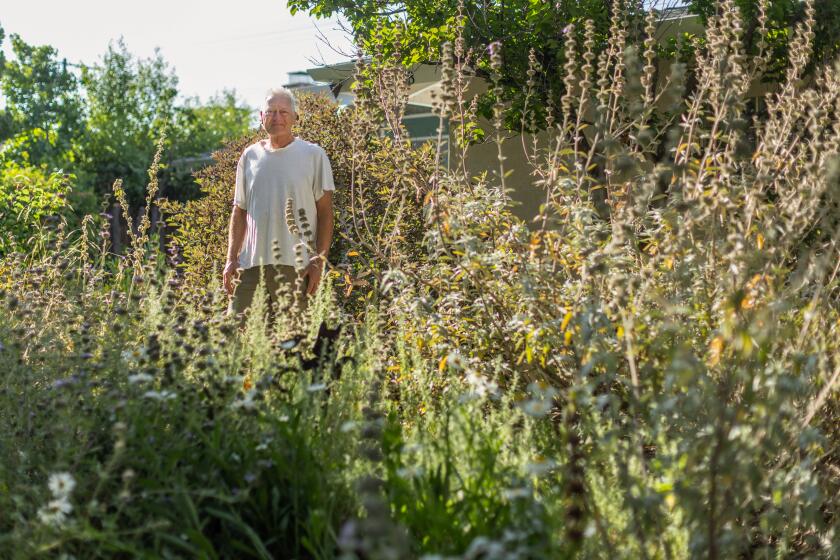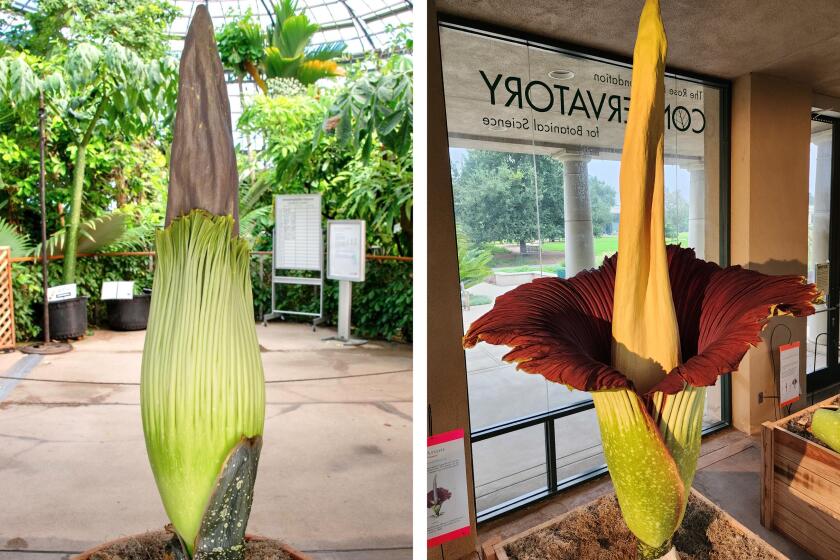Top of the Crop : Orange Country 4-H Club Puts Tomatoes to the Test--and Comes Up With Some Surprising Results
Everybody is talking tomatoes at this time of the year because it’s finally warm enough to plant the main-crop varieties. But which one?
Which variety tastes best, produces the most or makes the biggest hamburger-smothering slices? That’s what gardeners are debating over the back fence, at nurseries, even at the office.
Those who had problems in the past also want to know which kinds are the most resistance to cursed tomato diseases that can shrivel plants before their time.
While everyone has an opinion, some 4-H kids and parents in Orange County have hard facts--they put a baker’s dozen varieties to the test last summer with surprising results.
The Fountain Valley Cloverdale 4-H Club grew 18 plants each of 13 different tomato varieties commonly found at nurseries. That’s a grand total of 234 tomato plants, which is a pretty large test sample. They grew them in the loamy fields of the UC Cooperative Extension test station at Irvine, a nice average climate--not too different from your own. They kept careful track of size, productivity and resistance to disease.
Then they took lugs of juicy, summer-ripe fruit to a farmer’s market at the Orange County Fairgrounds, where some 200 shoppers rated them for taste. The results are shown in the accompanying table and it turned out that a variety named ‘Champion’ was indeed the champion.
That the ‘Sweet 100’ cherry tomato came in second shouldn’t surprise anyone who’s grown this tasty tomato.
But neither one may be the variety you’ll want to plant, because a relatively new and unknown tomato was more resistant to diseases, so easier to grow. Named ‘Husky Red,’ it was the surprising choice for “overall most successful variety,” while still garnering 86 points for taste on the group’s 0-100 scale, coming in third.
Equally surprising was how low the beefsteak-types rated for taste, though they were the most productive. One super-giant, ‘Beefmaster,’ came in dead last with only six points, even though individual tomatoes averaged an incredible 8.3 ounces each.
All of the tomatoes tested are called “main crop” varieties, planted late in spring for a summer crop. That’s why the popular ‘Early Girl’ is not included, although it did win an informal Times’ office taste test last summer.
The 4-Hers planted on May 27, and the taste tests were done in September. May is probably the best time to plant tomatoes, especially in the cool coastal areas. Planted much earlier, they will do a lot of growing but they won’t fruit until the weather gets consistently warm.
Start with plants in 4-inch or quart pots available at nurseries now, and plant them deep in soil enriched with compost and fertilizer, burying about two-thirds of the stem underground (roots will sprout all along it).
Allow the plant to sprawl, and tie it to a trellis or train it inside of a wire cage, which has been proved the most productive way to grow tomatoes. But you must make your own cages out of the welded wire mesh used to reinforce concrete driveways. For each cage, use an 80-inch length of 5-foot-wide wire with 6-inch mesh openings so you can reach inside. This will make a cage two-feet across and tall enough for most varieties.
Water deeply and often and do not cut off any foliage, as tests have shown that pruning or pinching hinders production. If you did a good job on the soil, there’s probably no need for additional fertilizer, and feeding may even reduce production.
If you’ve had troubles with tomato diseases in the past, try planting in a new spot and stick with the top six varieties, which were all moderately resistant. ‘Sweet 100,’ ‘Husky Red,’ ‘Gold,’ ‘Better Boy’ showed especially good resistance to the various wilts and viruses that visited the garden.
You can take comfort in the fact that the 4-Hers’ tomatoes had their share of problems, even in near-perfect soil with the extension personnel watering at precisely the right time. A plant pathologist identified verticillium wilt (caused by a fungus that lives for years in the soil), curly top virus (transmitted by leafhoppers), blossom end rot (complicated physiological problem), spotted wilt virus (transmitted by thrips) and tobacco mosaic (transmitted by touch and pruning).
Despite all these diseases, the kids, ages 8 to 18, managed to grow and then test some 1,500 pounds of tomatoes, which should help us suburban farmers figure out which one to plant in our little plot.
(BEGIN TEXT OF INFOBOX / INFOGRAPHIC)
How they stacked up
Some 200 shoppers at the Orange County Fairgrounds rated 13 varieties of tomatoes for taste on a scale of 0 to 100. The group tasted tomatoes from 234 plants grown at the UC Cooperative Extension test station in Irvine.
Taste Taste Variety Fruits per Average fruit Ranking points Name plant weight 1 100 Champion 30 4.5 oz 2 91 Sweet 100 Cherry n/a 0.5 3 86 Husky Red 32 4.0 4 82 Better Boy 18 4.9 5 75 Supersteak 19 6.4 6 72 Husky Gold 16 4.9 7 64 Big Girl 23 5.3 8 60 Big Beef 27 6.0 9 54 Gardener’s Delight Cherry n/a 0.5 10 46 Heartland 21 5.3 11 40 San Diego 19 4.8 12 36 Celebrity 17 6.0 13 6 Beefmaster 24 8.3



